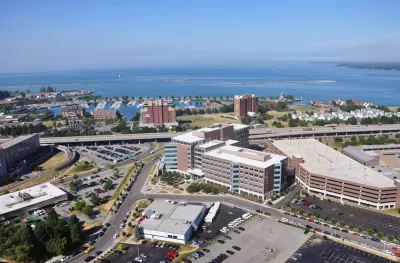The least congested cities tend to be small, declining, and dangerous.

Wendell Cox just wrote an essay trying to correlate density and congestion*, asserting that density means congestion and congestion is really, really bad (or in his words, “less traffic congestion benefits a metropolitan area's competitiveness.”)
So logically, the high-congestion cities should be declining, and the low-congestion places should be attracting Americans at a rapid rate. Right? Wrong.
In fact, the lowest-congestion cities tend to be a very mixed bag, while the high-congestion cities are doing relatively well. Cox lists ten high-congestion regions: Los Angeles, Houston, Austin, San Francisco, New York, Seattle, San Jose, Washington, Boston, and Portland. In all ten, the central city of the relevant region gained population between 2000 and 2010. These cities tend to be larger, relatively wealthy, high-cost cities, cities where keeping housing affordable is a bigger problem than demolition of worthless vacant lots.
And in all but two of these ten regions (all excepting Boston and Washington) the central city is more populous than in 1970. In these regions, there’s enough growth for city and suburb alike. Although some of these regions experienced regional population growth of 0-10 percent, not one of them shrunk, and two (Houston and Austin) grew by over 20 percent.
By contrast, Cox lists ten low-congestion regions: Indianapolis, Oklahoma City, Salt Lake City, St. Louis, Richmond, Kansas City, Memphis, Buffalo, Rochester, and Cleveland. A few of these (most notably Indianapolis, Oklahoma City and Salt Lake City) are doing reasonably well. But five of the central cities in Cox's "hero metros" lost population in the 2000s (Buffalo, Rochester, Cleveland, St. Louis, and Memphis) and two more gained population in the 2000s but are still less populous than in 1970 (Richmond and Kansas City). In fact, Buffalo and Cleveland even managed to lose population regionwide, and not one of Cox’s high performers grew by more than 16.7% (metro Salt Lake City’s growth rate).
In addition, these low-congestion cities tend to be far more dangerous than high-congestion cities. Their average murder rate in 2012 was 19.5 per 100,000 residents, while the high-congestion cities' murder rate was only 7 per 100,000—not surprising given the decline discussed above.** Only one of the low congestion cities (Salt Lake City) had a murder rate as low as the average for the ten high-congestion cities.
Residents of Cox's ten low-congestion cities have more reason to worry about dangerous drivers as well as dangerous criminals. I was able to find data for auto-related fatalities for sixteen of the twenty cities in Cox's two "top ten" lists; the high-congestion cities averaged 4.7 traffic deaths per 100,000 residents in 2011, while the low-congestion cities averaged 9.8. To put the matter another way, the most dangerous of the high-congestion cities (Houston) had 9.1 traffic deaths per 100,000 people, while five of nine low-congestion cities had more traffic deaths per capita than Houston. The second most dangerous high-congestion city (Austin, clocking in at 6.4 deaths per 100,000) had a lower fatality rate than all but one of the low-congestion cities.*** The least dangerous of the low-congestion cities, Rochester, New York had a higher traffic death rate than five of the seven high-congestion cities.
Does any of this show a causal relationship between urban decline and congestion? It might be that low congestion is simply a reflection of the small size and/or declining population of Cox’s "hero cities," rather than an independent variable. Or it could be that policies designed to limit congestion (like widening roads to support high speeds, chopping up downtowns with highways and turning them into giant parking craters) have actually had some positive effect for congestion, but at a heavy cost.
*I note that in this blog post, I am not going to address whether Cox has correctly defined congestion or density; my guess is that issue is being heavily debated elsewhere.
**Murder rates from city-data.com are as follows: Austin 3.7, Houston 10, Portland 3.3, New York 5.7, San Francisco 8.4, Boston 9, Los Angeles 7.8, Washington 13.9, Seattle 3.7, San Jose 4.6, Buffalo 18.3, Memphis 20.2, Kansas City 22.6, Oklahoma City 14.3, Salt Lake City 4.2, Cleveland 21.3, Richmond 20.2, St. Louis 35.5, Rochester 17, Indianapolis 11.6.
***I calculated the death rates myself from data at city-data.com. The rates per 100,000 for 2011 (the latest year for which the website supplied data) were: Houston 9.1, Austin 6.4, Portland 5.6, San Francisco 3.6, Boston 2.0, Seattle 3.1, San Jose 3.6, Buffalo 6.5, Memphis 11.3, Kansas City 14.2, Oklahoma City 12, Salt Lake City 9.5, Cleveland 6.6, Richmond 8.5, St. Louis 14.1, Rochester 5.7. I could not find data for Indianapolis, New York, Washington or Los Angeles.

Planetizen Federal Action Tracker
A weekly monitor of how Trump’s orders and actions are impacting planners and planning in America.

Maui's Vacation Rental Debate Turns Ugly
Verbal attacks, misinformation campaigns and fistfights plague a high-stakes debate to convert thousands of vacation rentals into long-term housing.

San Francisco Suspends Traffic Calming Amidst Record Deaths
Citing “a challenging fiscal landscape,” the city will cease the program on the heels of 42 traffic deaths, including 24 pedestrians.

Amtrak Rolls Out New Orleans to Alabama “Mardi Gras” Train
The new service will operate morning and evening departures between Mobile and New Orleans.

The Subversive Car-Free Guide to Trump's Great American Road Trip
Car-free ways to access Chicagoland’s best tourist attractions.

San Antonio and Austin are Fusing Into one Massive Megaregion
The region spanning the two central Texas cities is growing fast, posing challenges for local infrastructure and water supplies.
Urban Design for Planners 1: Software Tools
This six-course series explores essential urban design concepts using open source software and equips planners with the tools they need to participate fully in the urban design process.
Planning for Universal Design
Learn the tools for implementing Universal Design in planning regulations.
Heyer Gruel & Associates PA
JM Goldson LLC
Custer County Colorado
City of Camden Redevelopment Agency
City of Astoria
Transportation Research & Education Center (TREC) at Portland State University
Jefferson Parish Government
Camden Redevelopment Agency
City of Claremont





























